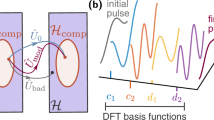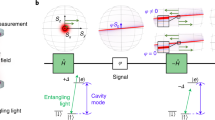Abstract
In quantum mechanics, measurements cause wavefunction collapse that yields precise outcomes, whereas for non-commuting observables such as position and momentum Heisenberg’s uncertainty principle limits the intrinsic precision of a state. Although theoretical work1 has demonstrated that it should be possible to perform simultaneous non-commuting measurements and has revealed the limits on measurement outcomes, only recently2,3 has the dynamics of the quantum state been discussed. To realize this unexplored regime, we simultaneously apply two continuous quantum non-demolition probes of non-commuting observables to a superconducting qubit. We implement multiple readout channels by coupling the qubit to multiple modes of a cavity. To control the measurement observables, we implement a ‘single quadrature’ measurement by driving the qubit and applying cavity sidebands with a relative phase that sets the observable. Here, we use this approach to show that the uncertainty principle governs the dynamics of the wavefunction by enforcing a lower bound on the measurement-induced disturbance. Consequently, as we transition from measuring identical to measuring non-commuting observables, the dynamics make a smooth transition from standard wavefunction collapse to localized persistent diffusion and then to isotropic persistent diffusion. Although the evolution of the state differs markedly from that of a conventional measurement, information about both non-commuting observables is extracted by keeping track of the time ordering of the measurement record, enabling quantum state tomography without alternating measurements. Our work creates novel capabilities for quantum control, including rapid state purification4, adaptive measurement5,6, measurement-based state steering and continuous quantum error correction7. As physical systems often interact continuously with their environment via non-commuting degrees of freedom, our work offers a way8,9 to study how notions of contemporary quantum foundations10,11,12,13,14 arise in such settings.
This is a preview of subscription content, access via your institution
Access options
Subscribe to this journal
Receive 51 print issues and online access
$199.00 per year
only $3.90 per issue
Buy this article
- Purchase on Springer Link
- Instant access to full article PDF
Prices may be subject to local taxes which are calculated during checkout




Similar content being viewed by others
References
Arthurs, E. & Kelly, J. L. On the simultaneous measurement of a pair of conjugate observables. Bell Syst. Tech. J. 44, 725–729 (1965)
Jordan, A. N. & Büttiker, M. Continuous quantum measurement with independent detector cross correlations. Phys. Rev. Lett. 95, 220401 (2005)
Ruskov, R., Korotkov, A. N. & Mølmer, K. Qubit state monitoring by measurement of three complementary observables. Phys. Rev. Lett. 105, 100506 (2010)
Ruskov, R., Combes, J., Mølmer, K. & Wiseman, H. M. Qubit purification speed-up for three complementary continuous measurements. Phil. Trans. R. Soc. A 370, 5291–5307 (2012)
Jacobs, K. How to project qubits faster using quantum feedback. Phys. Rev. A 67, 030301 (2003)
Wiseman, H. M. Adaptive phase measurements of optical modes: going beyond the marginal Q distribution. Phys. Rev. Lett. 75, 4587–4590 (1995)
Ahn, C., Doherty, A. C. & Landahl, A. J. Continuous quantum error correction via quantum feedback control. Phys. Rev. A 65, 042301 (2002)
Luis Pedro Garca-Pintos, J. D. Probing quantumness with joint continuous measurements of non-commuting qubit observables. Preprint at http://arXiv.org/abs/1606.07934 (2016)
Nishizawa, A. & Chen, Y. Universally valid error-disturbance relations in continuous measurements. Preprint at http://arXiv.org/abs/1506.00304 (2015)
Kirchmair, G. et al. State-independent experimental test of quantum contextuality. Nature 460, 494–497 (2009)
Kochen, S. & Specker, E. P. The problem of hidden variables in quantum mechanics. J Math. Mech. 17, 59–87 (1968)
Erhart, J. et al. Experimental demonstration of a universally valid error-disturbance uncertainty relation in spin measurements. Nat. Phys. 8, 185–189 (2012)
Dressel, J. & Nori, F. Certainty in Heisenberg’s uncertainty principle: revisiting definitions for estimation errors and disturbance. Phys. Rev. A 89, 022106 (2014)
Ozawa, M. Universally valid reformulation of the Heisenberg uncertainty principle on noise and disturbance in measurement. Phys. Rev. A 67, 042105 (2003)
Koch, J. et al. Charge-insensitive qubit design derived from the Cooper pair box. Phys. Rev. A 76, 042319 (2007)
Gambetta, J. et al. Quantum trajectory approach to circuit QED: quantum jumps and the Zeno effect. Phys. Rev. A 77, 012112 (2008)
Hatridge, M. et al. Quantum back-action of an individual variable-strength measurement. Science 339, 178–181 (2013)
Murch, K. W., Weber, S. J., Macklin, C. & Siddiqi, I. Observing single quantum trajectories of a superconducting quantum bit. Nature 502, 211–214 (2013)
Caves, C. M., Thorne, K. S., Drever, R. W., Sandberg, V. D. & Zimmermann, M. On the measurement of a weak classical force coupled to a quantum-mechanical oscillator. Rev. Mod. Phys. 52, 341–392 (1980)
Hertzberg, J. B. et al. Back-action-evading measurements of nanomechanical motion. Nat. Phys. 6, 213–217 (2010)
Murch, K. W. et al. Cavity-assisted quantum bath engineering. Phys. Rev. Lett. 109, 183602 (2012)
Didier, N., Bourassa, J. & Blais, A. Fast quantum nondemolition readout by parametric modulation of longitudinal qubit-oscillator interaction. Phys. Rev. Lett. 115, 203601 (2015)
Nielson, M. A. & Chuang, I. L. Quantum Computation and Quantum Information (Cambridge Univ. Press, 2010)
Six, P. et al. Quantum state tomography with noninstantaneous measurements, imperfections, and decoherence. Phys. Rev. A 93, 012109 (2016)
MacCone, L. & Pati, A. K. Stronger uncertainty relations for all incompatible observables. Phys. Rev. Lett. 113, 260401 (2014)
Vool, U. et al. Continuous quantum nondemolition measurement of the transverse component of a qubit. Preprint at http://arXiv.org/abs/1605.08004 (2011)
Combes, J., Wiseman, H. M. & Scott, A. J. Replacing quantum feedback with open-loop control and quantum filtering. Phys. Rev. A 81, 020301 (2010)
Dressel, J. Indirect Observable Measurement: an Algebraic Approach. 52 PhD thesis, Univ. Rochester (2013)
Castellanos-Beltran, M. A., Irwin, K. D., Hilton, G. C., Vale, L. R. & Lehnert, K. W. Amplification and squeezing of quantum noise with a tunable Josephson metamaterial. Nat. Phys. 4, 929–931 (2008)
Macklin, C. et al. A near quantum-limited Josephson traveling-wave parametric amplifier. Science 350, 307–310 (2015)
Korotkov, A. N. Quantum Bayesian approach to circuit QED measurement. Preprint at http://arXiv.org/abs/1111.4016 (2011)
Acknowledgements
We thank J. Dressel, A. Jordan, A. Korotkov, J. Combes, M. Sarovar, U. Vool and J. Atalaya for discussions, and MIT Lincoln laboratories for fabrication of the travelling wave parametric amplifier. L.S.M. and V.V.R. acknowledge support from the National Science Foundation (graduate fellowship grant 1106400). L.S.M. additionally acknowledges support from a Berkeley Fellowship for Graduate Study. This work was supported by the Air Force Office of Scientific Research (grant FA9550-12-1-0378) and the Army Research Office (grant W911NF-15-1-0496).
Author information
Authors and Affiliations
Contributions
S.H.-G. and L.S.M. wrote the manuscript, conducted the experiment and analysed the data. S.H.-G., L.S.M., E.F. and I.S. conceived of the experiment. S.H.-G. and L.S.M. constructed the experimental set-up with assistance from V.V.R. and E.F. S.H.-G. fabricated the qubit and LJPAs. L.S.M. performed theoretical analysis with assistance from S.H.-G. All authors contributed to discussions and preparation of the manuscript. All work was carried out under the supervision of K.B.W. and I.S.
Corresponding author
Ethics declarations
Competing interests
The authors declare no competing financial interests.
Extended data figures and tables
Extended Data Figure 1 SQM versus tomographic validation.
Tomographic validation of a set of trajectories initialized in the state y = −1 and tracked for 3 μs, with the axes being perpendicular. Horizontal axis (‘SQM’) indicates Bloch sphere coordinate as predicted by trajectory reconstruction. Vertical axis (‘tomography’) represents the coordinate reconstructed from post-selected tomography data. Error bars (s.e.m.) are derived from the Poisson statistics of the qubit measurement. Data are staggered vertically to allow for clearer visualization by adding one of seven arbitrary offsets. These offsets are chosen according to the number of measurements contributing to each data point.
Extended Data Figure 2 SQM calibration.
Calibration of the SQM phase at the target Rabi frequency using the integrated SQM signal versus the measurement axis (SQM phase) and the Rabi amplitude index. Colour bar is scaled to the outcomes in which the qubit is aligned or anti-aligned to the measurement axis. Rabi amplitude index sweep is performed by sweeping the modulation amplitude to drive approximately 40-MHz Rabi oscillations. The red dashed line indicates the index at which the Rabi frequency was determined to be 40 MHz.
Rights and permissions
About this article
Cite this article
Hacohen-Gourgy, S., Martin, L., Flurin, E. et al. Quantum dynamics of simultaneously measured non-commuting observables. Nature 538, 491–494 (2016). https://doi.org/10.1038/nature19762
Received:
Accepted:
Published:
Issue Date:
DOI: https://doi.org/10.1038/nature19762
This article is cited by
-
Realizing a deep reinforcement learning agent for real-time quantum feedback
Nature Communications (2023)
-
Demonstration of universal control between non-interacting qubits using the Quantum Zeno effect
npj Quantum Information (2022)
-
Coherent interaction-free detection of microwave pulses with a superconducting circuit
Nature Communications (2022)
-
Engineered dissipation for quantum information science
Nature Reviews Physics (2022)
-
Quantum non-demolition measurement of a many-body Hamiltonian
Nature Communications (2020)
Comments
By submitting a comment you agree to abide by our Terms and Community Guidelines. If you find something abusive or that does not comply with our terms or guidelines please flag it as inappropriate.



